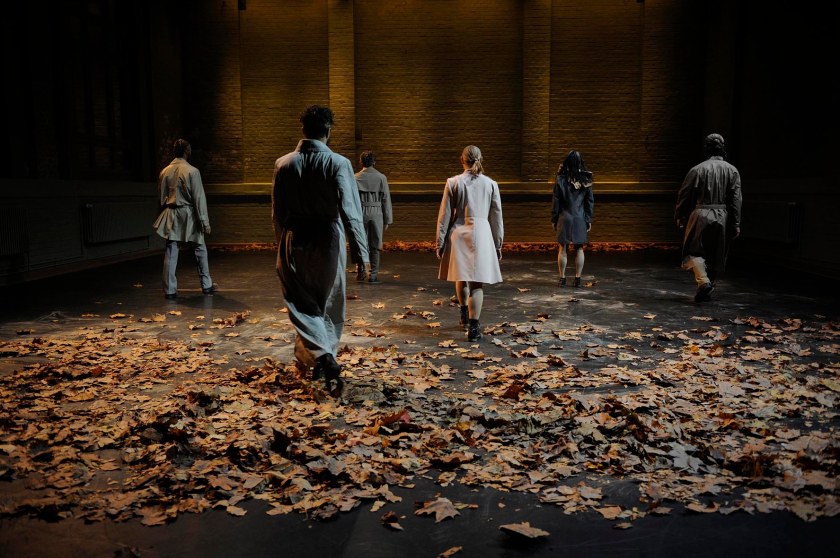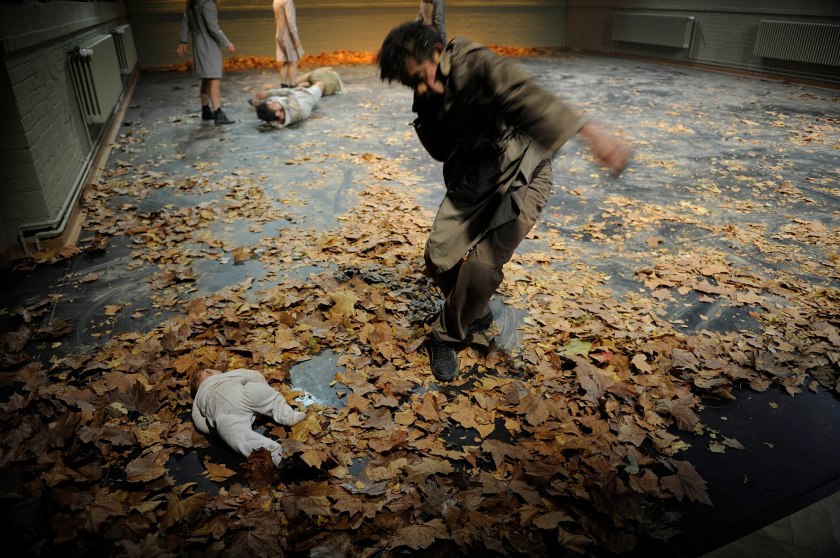
Toula Limnaios isn’t interested in your opinion of her work. According to an interview recorded for Tanzforum Berlin in 2006, the Greek artistic director of the contemporary dance company cie. toula limnaios is preoccupied with providing an experience. What the viewer does with that experience is her own business. The company performed “Tempus Fugit,” the choreographer’s commentary on the passage of time (“how we perceive (it) and what it means to people,”) at the company’s home theater Halle Tanzbühne Berlin. For the viewer who couldn’t be physically present, I’ve taken it upon myself to describe my own experience at a performance on August 3rd. Take what you will. And if it provokes you, I would assume that Limnaios would suggest you put that aggression toward making something artistic of your own.

- cie. toula limnaios: ‘tempus fugit’, 2016 // Copyright Dieter Hartwig
Mahler’s Fifth Symphony descends as dancers pull themselves onto a dimly-lit floor. The way is paved with a path of leaves spread along the front of the stage, continuing in a zig-zag pattern toward the back wall. As the number of dancers builds from one to seven along this path, the heaviness and finality of the music becomes a visceral experience; with every drag, thump, and roll, leaves rustle and crunch, and the floor reverberates underneath the spectators’ feet.
Unison of movement pulsates throughout like a power generator. The seven dancers, three women and four men dressed in trench coats and simple clothes, move with knee-buckling heaviness. The sameness of their movements sheds all constraint of gender and story. As if propelled by a mutual heartbeat transporting the group from one place to another, the unit builds intensity over the course of seventy minutes. Dancers fall backwards with lifted chests, a contrast of airy upper bodies to their heavy footing.

A combination of varying musical aestheics alternate; sections of Mahler and Hayden symphonies are connected with moments of space-agey dissonance by Ralf R. Ollertz, the company’s musical director. Mahler creates the impression of impending doom in ultra slow motion, while Hayden highlights the simplicity and purity also present in Limnaios’ movement language. Ollertz’s atonal interludes give these sections an other-worldly quality, where the day-to-day takes a break, and time stops entirely.
An inanimate eighth body disturbs the group’s chemistry midway through; a baby doll, a life-like dummy with the weight and movement quality of a real baby, is introduced to the scene. The concept starts off strong (albeit strange) as a dancer controls the baby’s positions while constellations of dancers mimic those movements. The slump of dead weight, the tenderness of a person innocently leaning against another, even the transfer of responsibility from one puppeteer to another, all lend original elements to the dance. But realistically, when a baby is thrown across a room, its head crashing against the floor again, and again, it’s hard to feel compassion for anyone but the baby, even if the bodies following suit are actual living flesh and blood.

Once the game of Simon Says has exhausted all possibilities, the baby lies discarded in a pile of leaves while the dancers wrap up their dance. As the group forms clusters of small synchronized movements, individual dancers perform solos of sporadic quick movements against the group’s slow support. This action almost distracts from the discarded infant lying downstage–but not quite. Out of nowhere, a woman laughs hysterically. The group screams for ten seconds, and it wouldn’t do any good to ask why.
The program notes provide a quote from Friedrich Nietzsche to give direction to this perplexing work: “A leaf is continually dropping out of the volume of time and fluttering away—and suddenly it flutters back into the man’s lap.” But I won’t try to analyze anything. For me, it is the physicality of a body falling heavily as leaves crunch to dust and get caught in hair, and as built-up sweat darkens the coats on the dancers’ backs, that makes this dance interesting. The choreographer’s original movement language, a play of off-balanced footing paired with fluid upper bodies, is enough for a dance. And that’s enough for me.

Learn more and view the ’17-’18 season performance schedule: cie. toula limnaios
cool piece. Poor baby!
On Thu, Sep 14, 2017 at 4:56 AM, Berlin: A Review wrote:
> Berlin Artifact posted: ” cie. toula limnaios performs “Tempus Fugit” at > Halle Tanzbühne Berlin Toula Limnaios isn’t interested in your opinion of > her work. According to an interview recorded for Tanzforum Berlin in 2006, > the Greek artistic director of the contemporary dance com” >
LikeLike
Love these physical descriptions — they go so well with the eerie photos!
LikeLike
Thanks Paul!
LikeLike